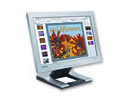'ZDNET Recommends': What exactly does it mean?
ZDNET's recommendations are based on many hours of testing, research, and comparison shopping. We gather data from the best available sources, including vendor and retailer listings as well as other relevant and independent reviews sites. And we pore over customer reviews to find out what matters to real people who already own and use the products and services we’re assessing.
When you click through from our site to a retailer and buy a product or service, we may earn affiliate commissions. This helps support our work, but does not affect what we cover or how, and it does not affect the price you pay. Neither ZDNET nor the author are compensated for these independent reviews. Indeed, we follow strict guidelines that ensure our editorial content is never influenced by advertisers.
ZDNET's editorial team writes on behalf of you, our reader. Our goal is to deliver the most accurate information and the most knowledgeable advice possible in order to help you make smarter buying decisions on tech gear and a wide array of products and services. Our editors thoroughly review and fact-check every article to ensure that our content meets the highest standards. If we have made an error or published misleading information, we will correct or clarify the article. If you see inaccuracies in our content, please report the mistake via this form.
Samsung SyncMaster 172W


Samsung SyncMaster 172W
pros and cons
- Wide-screen viewing without the letterbox effect collapsible dual-purpose stand good image quality.
- Too expensive compared to the XGA displays with which it should be competing.
- Editors' review
- Specs
Aspect ratio is a piece of jargon you don’t hear all that much about. Attention tends to focus more on resolution, so a monitor is typically described as delivering, say, 1,024 by 768 resolution rather than as having an aspect ratio of 1.33:1 (or 4:3). This is hardly surprising, since the aspect ratio -- the relationship between the width and the height of the image -- deriving from standard screen resolutions is the same from 640 by 480 VGA, through 1,024 by 768 XGA and up to 1,600 by 1,200 UXGA: 1.33:1.
In fact, this ratio has a hallowed ancestry dating back to the dawn of cinema in the late 1890s. Cinematic convention crossed over into the television age in America in the early 1950s, when the same aspect ratio was adopted as the standard for TV tubes. In turn, the US TV industry bequeathed the magic 1.33:1 to the computer business, and that's why the screens of computer monitors are the shape they are. Samsung is bowing to the influence of film and television once again with its latest flat-panel display, which owes its shape to wide-screen cinematic formats and HDTV. The SyncMaster 172W abandons the traditional 1.33:1 aspect ratio in favour of a wider screen delivering a 1.66:1 (5:3) aspect ratio. In order to do this, Samsung has combined elements of two extended resolutions to make an extra-wide hybrid that fits the extra-wide screen. So instead of 1,024 by 768 or 1,280 by 1,024, the SyncMaster 172W operates at 1,280 by 768. This just happens to be a near-exact fit with one of the agreed HDTV standards of 1,280 by 720. You need a special driver for this, which is provided and also easily downloadable in its latest version from Samsung's Web site. Apart from installing the driver (the work of a moment), the setup process is as straightforward as it should be: you press the Auto Setup button on the bezel, and the image sizes, centres and tunes itself to the signal source all by itself.Design
The SyncMaster 172W sports a clever double-hinged stand, which can fold back on itself and act as a wall mount as well as a conventional desktop tilt support. This is actually a necessity, as the signal inputs and power lead from the external power brick all connect at the base of the stand rather than directly into the cabinet, so it cannot actually be removed.
You have a choice of standard analogue D-Sub VGA or digital-only DVI-D, and there's a button on the bezel for toggling between them if you are using the monitor with two input devices.
The whole thing is surprisingly compact, with a nice, thin cabinet and a reasonably narrow bezel. The widened screen doesn't look odd, just different, and it preserves the conventional 17in. viewable diagonal of mid-sized computer displays despite its unusual aspect ratio.
Running Windows at the SyncMaster's native 1,280 by 768 resolution isn't quite the treat you get when you upgrade from 1,024 by 768 to full 1,280 by 1,024, but there's an appreciable amount more width in the desktop. Better still, the resolution and the physical size of the screen don't work against each other, so text, icons and other screen objects are big enough to be usable without requiring the eyes and hands of a neurosurgeon.
Image quality
The image is very bright, and colours both vibrant and even. We did notice that the width of the screen pushed against the range of horizontal viewing angles slightly, so that unless the monitor is viewed from exactly dead centre, the edge furthest away was fractionally darker. However, this wasn't pronounced enough to hole the 172W below the waterline.
Samsung makes a moderate amount of fuss about the 172W's MagicBright feature, which as far as we could tell is actually no more than a selection of brightness presets recommended for different tasks -- Text, Internet and Entertain. Sensibly enough, Text is the least bright, and Entertain the brightest. If this is not for you, the brightness level can be adjusted via the on-screen menu, along with much else.
Fine tuning colour is a simple choice between a preset default or reddish/bluish -- you only get to the more complex business of individually adjusting the RGB intensities if you delve into the user-defined option. This probably won't be necessary for most people.
Wide-screen benefits?
So far so good, but while testing the monitor, we began to wonder what the real benefits of this wide-screen approach were. After all, if you watch a wide-screen format DVD or input HDTV via a tuner card, you'll get the same results on a 17in. 1,280 by 1,024 resolution flat panel as you would on the SyncMaster 172W. Bear in mind that both monitors share the same horizontal resolution of 1,280 pixels, so both deliver the same width of image. True, there'd be more visible dead space above and below the image on a conventional display, but this becomes increased Windows desktop area when you are running applications, which must surely be a fair trade-off.
The key seems to be price. If the SyncMaster 172W gave you the width of a 17in. flat panel for the price of a 15in. screen, it would make its case. So imagine our puzzlement when we checked its price against the SyncMaster 172T, which is the same in all respects but has a standard 17in. 1,280 by 1,024 resolution screen. Instead of being cheaper, the wide-screen 172W was £20 more expensive.
Perhaps the 172W is physically wider than a standard 1,280 by 1,024 panel. Out came the tape measure and we can confirm that it is -- by 3cm. This will make the image a bit larger overall, but we we're not at all sure it tips the balance in favour of the 172W -- or at least not at its current price.
As things stand, this monitor's key appeal seems to be limited to its unusual and eye-catching shape. When you actually get down to it, there's no real technical advantage, and you'd be better off with a standard 17in. 1,280 by 1,024 display, unless you are genuinely unable to stand the sight of a bit of black above and below whatever it is you are watching.